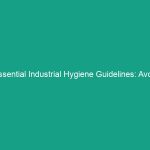Good Morning Team!
Today, we’re diving into an essential topic that affects all of us on the job site: Must-Know System Scaffold Guidelines: Avoid Critical Safety Risks. Understanding and following scaffold guidelines is crucial to ensuring our Safety and the safety of our colleagues. Safety should always be our top priority, especially when working at heights. Let’s explore why these guidelines are so important and how we can implement them effectively to avoid accidents.
Understanding System Scaffold Guidelines
System scaffold guidelines refer to the Standards and Procedures that govern the safe use, assembly, and Maintenance of scaffolding systems. These guidelines are designed to protect workers from falls, injuries, and other Hazards associated with elevated work. By adhering to these guidelines, we can ensure that scaffolding is used safely and effectively, minimizing the risk of accidents on the job site.
Many employees might think that scaffolding is straightforward and that injuries are rare. However, the reality is that improper use or neglect of scaffold safety can lead to severe consequences, including falls that could result in serious injuries or fatalities. It’s critical that we all understand our role in maintaining a safe work Environment.
Key Hazards, Risks, and Safety Considerations
When working with scaffolding, several hazards and risks can arise, including:
- Falls from Heights: This is the most significant risk associated with scaffolding. Workers can fall if the scaffold is not built correctly or if proper Safety Measures are not in place.
- Scaffold Collapse: A poorly erected scaffold can collapse, leading to multiple injuries.
- Electrocution: Scaffolding can come into contact with overhead power lines, posing serious electrocution risks.
- Inadequate Safety Equipment: Failing to use proper Personal Protective Equipment (PPE) can increase the risk of injury.
Ignoring these hazards can lead to devastating outcomes, not only for individuals but also for the entire team. We must take proactive steps to mitigate these risks effectively.
Best Practices, Procedures, & Actionable Advice
To ensure safety when working with scaffolding, consider the following Best Practices:
1. Inspect Scaffolding Regularly
Before using any scaffold, conduct a thorough inspection to check for:
- Structural integrity.
- Secure connections between components.
- Properly placed guardrails.
- Level footing and stable ground.
Regular inspections can help identify potential issues before they become serious problems. If you notice anything suspicious, report it immediately.
2. Use Proper Assembly Techniques
Always follow the manufacturer’s assembly instructions closely. Ensure that:
- The scaffold is erected on stable ground.
- All components are compatible and properly secured.
- Cross bracing is installed for added stability.
3. Wear Appropriate Personal Protective Equipment (PPE)
Ensure you are wearing the correct PPE, which may include:
- Hard hats to protect against falling objects.
- Safety harnesses if working at heights.
- Steel-toed boots to protect your feet.
PPE is your last line of defense against injuries, so always wear it when working on or near scaffolding.
4. Ensure Proper Training
All employees should receive training on scaffold safety and proper use. This training should cover:
- How to identify hazards associated with scaffolding.
- Safe assembly and disassembly procedures.
- Emergency response procedures in case of a scaffold failure.
Training is essential to ensure everyone understands the risks and how to mitigate them effectively.
Regulations, Standards, and Compliance
Adhering to safety Regulations is not just a best practice; it’s a legal requirement. In the United States, the Occupational Safety and Health Administration (OSHA) sets forth regulations for scaffolding in 29 CFR 1926 Subpart L, which outlines the requirements for the safe use of scaffolding. Compliance with these regulations is critical for several reasons:
- Legal Protection: Following osha guidelines protects you and the company from legal ramifications.
- Enhanced Safety: Compliance leads to a safer working environment, reducing the risk of accidents.
- Professional Credibility: Demonstrating commitment to safety enhances the company’s reputation.
Always stay updated on changes in regulations and ensure that you are following company-specific safety protocols as well.
Employee Engagement & Discussion
Now that we’ve covered the essential scaffolding guidelines, let’s engage in a discussion. What safety challenges have you encountered related to scaffolding? Have you witnessed any unsafe practices on the job site? Sharing our experiences can help us learn from one another and improve our safety culture.
Conclusion & Key Takeaways
In summary, understanding and following system scaffold guidelines is crucial to avoiding critical safety risks. By regularly inspecting scaffolding, using proper assembly techniques, wearing appropriate PPE, and ensuring comprehensive training, we can create a safer work environment for everyone. Remember, safety is not just a priority; it’s a responsibility that we all share.
Thank you for your attention and commitment to safety. Let’s continue to work together to ensure that everyone returns home safely at the end of the day. Stay safe, and let’s make today a productive and secure workday!


